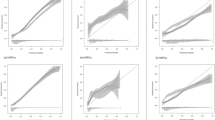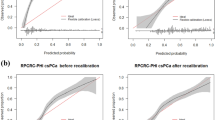Abstract
Purposes
The prostate biopsy collaborative group risk calculator (PBCGRC) is a newly developed risk estimator for predicting prostate biopsy outcomes. However, its clinical usefulness is still unknown within the so-called gray area of PSA values. This study aimed to determine whether updating the PBCGRC improves its predictive performance for predicting any-grade and high-grade (HG), defined as biopsy Gleason score ≥ 7, prostate cancer (PCa) in patients with prostate-specific antigen (PSA) less than 10 ng/ml.
Methods
The risk of any-grade and HGPCa was calculated using the PBCG risk calculation formulas updated by recalibration in the large, logistic recalibration and model revision. Predictive performances of the PBCGRC and the updated models were compared using discrimination, calibration, and clinical utility.
Results
Within the study sample of 526 patients, PCa was detected in 193 (36.7%), and 78 (14.8%) of them had HGPCa. According to the calibration curves, the PBCGRC overestimated the risk of PCa. Predictive accuracy of the revised model was higher [the area under the receiver-operating characteristic curve (AUCs), 65.4% and 70.2%] than that of the PBCGRC (AUCs, 60.4% and 64.3%) for any-grade and HGPCa. The net benefit was greater for model revision in comparison with the original model.
Conclusion
The performance accuracy of PBCGRC for the prediction of any and HGPC in men undergoing prostate biopsy with PSA levels below 10 ng/ml is suboptimal. The model revision resulted with significant improvement in model performance. However, external validation of the revised model is necessary before its routine use in clinical practice.



Similar content being viewed by others
References
Kawamura K, Suzuki H, Kamiya N et al (2008) Development of a new nomogram for predicting the probability of a positive initial prostate biopsy in Japanese patients with serum PSA levels less than 10 ng/mL. Int J Urol 15(7):598–603
Ohigashi T, Kanao K, Mizuno R et al (2010) Predicting the probability of significant prostate cancer in Japanese men with serum prostate-specific antigen less than 10 ng/mL: development of a novel pre-biopsy nomogram. Int J Urol 17(3):274–280
Perdonà S, Cavadas V, Di Lorenzo G et al (2011) Prostate cancer detection in the "grey area" of prostate-specific antigen below 10 ng/ml: head-to-head comparison of the updated PCPT calculator and Chun's nomogram, two risk estimators incorporating prostate cancer antigen 3. Eur Urol 59(1):81–87
Gomez Gomez E, Salamanca Bustos JJ, Carrasco Valiente J et al (2019) Observational study comparing the accuracy/variability between the ERSPC and the PCPT risk calculators for the prediction of significant prostate cancer in patients with PSA %3c 10 ng/mL. BMJ Open 9(11):e031032
Ankerst DP, Straubinger J, Selig K et al (2018) A contemporary prostate biopsy risk calculator based on multiple heterogeneous cohorts. Eur Urol 74(2):197–203
Carbunaru S, Nettey OS, Gogana P et al (2019) Acomparative effectiveness analysis of the PBCG vs. PCPT risks calculators in amulti-ethnic cohort. BMC Urol 19(1):121
Lughezzani G, Lazzeri M, Larcher A et al (2012) Development and internal validation of a Prostate Health Index based nomogram for predicting prostate cancer at extended biopsy. J Urol 188(4):1144–1150
Zhu Y, Han CT, Zhang GM et al (2015) Development and external validation of a prostate health index-based nomogram for predicting prostate cancer. Sci Rep 5:15341
Loeb S, Shin SS, Broyles DL et al (2017) Prostate Health Index improves multivariable risk prediction of aggressive prostate cancer. BJU Int 120(1):61–68
Poyet C, Nieboer D, Bhindi B et al (2016) Prostate cancer risk prediction using the novel versions of the European Randomised Study for Screening of Prostate Cancer(ERSPC) and Prostate Cancer Prevention Trial (PCPT) risk calculators: independent validation and comparison in a contemporary European cohort. BJU Int 117(3):401–408
Kappen TH, Vergouwe Y, van Klei WA et al (2012) Adaptation of clinical prediction models for application in local settings. Med Decis Making 32(3):E1–10
Chiu PK, Roobol MJ, Nieboer D et al (2017) Adaptation and external validation of the European randomised study of screening for prostate cancer risk calculator for the Chinese population. Prostate Cancer Prostatic Dis 20(1):99–104
Alberts AR, Roobol MJ, Verbeek JFM et al (2019) Prediction of high-grade prostate cancer following multiparametric magnetic resonance imaging: improving the Rotterdam European Randomized Study of Screening for Prostate Cancer Risk Calculators. Eur Urol 75(2):310–318
Ankerst DP, Goros M, Tomlins SA et al (2019) Incorporation of urinary prostate cancer antigen 3 and TMPRSS2:ERG into prostate cancer prevention trial risk calculator. Eur Urol Focus 5(1):54–61
Epstein JI, Allsbrook WC Jr, Amin MB, ISUP Grading Committee et al (2005) The 2005 International Society of Urological Pathology (ISUP) consensus conference on gleason grading of prostatic carcinoma. Am J Surg Pathol 29(9):1228–1242
Van Calster B, Van Hoorde K, Vergouwe Y et al (2017) Validation and updating of risk models based on multinomial logistic regression. Diagn Progn Res 1:2
Vergouwe Y, Nieboer D, Oostenbrink R et al (2017) A closed testing procedure to select an appropriate method for updating prediction models. Stat Med 36(28):4529–4539
Li J, Gao M, D'Agostino R (2019) Evaluating classification accuracy for modern learning approaches. Stat Med 38(13):2477–2503
Vickers AJ, Van Calster B, Steyerberg EW (2016) Net benefit approaches to the evaluation of prediction models, molecular markers, and diagnostic tests. BMJ 25(352):i6
Foj L, Filella X (2020) Development and internal validation of a novel PHI-nomogram to identify aggressive prostate cancer. Clin Chim Acta 501:174–178
Haese A, Trooskens G, Steyaert S et al (2019) Multicenter optimization and validation of a 2-gene mRNA urine test for detection of clinically significant prostate cancer before initial prostate biopsy. J Urol 202(2):256–263
Xu N, Wu YP, Chen DN et al (2018) Can prostate imaging reporting and data system version 2 reduce unnecessary prostate biopsies in men with PSA levels of 4–10 ng/ml? J Cancer Res Clin Oncol 2018144(5):987–995
Castro HAS, Iared W, Santos JEM et al (2018) Impact of PSA density of transition zone as a potential parameter in reducing the number of unnecessary prostate biopsies in patients with PSA levels between 2.6 and 10.0 ng/mL. Int Braz J Urol. 44(4):709–716
Jansson F, Drevin L, Frisell T et al (2018) Concordance of non-low-risk disease among pairs of brothers with prostate cancer. J Clin Oncol 36(18):1847–1852
Boegemann M, Stephan C, Cammann H et al (2016) The percentage of prostate-specific antigen (PSA) isoform[-2]proPSA and the Prostate Health Index improve the diagnostic accuracy forclinically relevant prostate cancer at initial and repeat biopsy compared withtotal PSA and percentage free PSA in men aged ≤65 years. BJU Int 117(1):72–79
Bryant RJ, Sjoberg DD, Vickers AJ et al (2015) Predicting high-grade cancer at ten-core prostate biopsy using four kallikrein markers measured in blood in the Protect study. J Natl Cancer Inst. 2015107(7):djv095
Creed J, Klotz L, Harbottle A et al (2018) A single mitochondrial DNA deletion accurately detects significant prostatecancer in men in the PSA 'grey zone'. World J Urol 201836(3):341–348
De Nunzio C, Lombardo R, Tema G et al (2018) External validation of Chun, PCPT, ERSPC, Kawakami, and Karakiewicz nomograms in the prediction of prostate cancer: a single center cohort-study. Urol Oncol 36(8):364.e1–364.e7
Louie KS, Seigneurin A, Cathcart P et al (2015) Do prostate cancer risk models improve the predictive accuracy of PSA screening? A meta-analysis. Ann Oncol 26(5):848–864
Siregar S, Nieboer D, Versteegh MIM et al (2019) Methods for updating a risk prediction model for cardiac surgery: a statistical primer. Interact Cardiovasc Thorac Surg. 28(3):333–338
Van Calster B, McLernon DJ, van Smeden M et al (2019) Calibration: the Achilles heel of predictive analytics. BMC Med 17(1):230
Luijken K, Wynants L, van Smeden M et al (2020) Changing predictor measurement procedures affected the performance of prediction models in clinical examples. J Clin Epidemiol 119:7–18
Ankerst DP, Hoefler J, Bock S et al (2014) Prostate Cancer Prevention Trial risk calculator 2.0 for the prediction of low- vs high-grade prostate cancer. Urology 83(6):1362–1367
Grill S, Fallah M, Leach RJ et al (2015) (2015) Incorporation of detailed family history from the Swedish Family Cancer Database into the PCPT risk calculator. J Urol 193(2):460–465
Chen H, Liu X, Brendler CB et al (2016) Adding genetic risk score to family history identifies twice as many high-risk men for prostate cancer: results from the prostate cancer prevention trial. Prostate 76(12):1120–1129
Leitão TP, Alfarelos J, Rodrigues T et al (2017) A prospective randomized trial comparing the vienna nomogram and a ten-core prostate biopsy protocol: effect on cancer detection rate. Clin Genitourin Cancer 15(1):117–121
Acknowledgements
The authors were financially supported through a research Grant N0175014 and N175007 of the Ministry of Science and Technological Development of Serbia. The authors thank the Ministry for this support.
Author information
Authors and Affiliations
Corresponding author
Ethics declarations
Conflict of interest
The authors declare no conflict of interest.
Additional information
Publisher's Note
Springer Nature remains neutral with regard to jurisdictional claims in published maps and institutional affiliations.
Rights and permissions
About this article
Cite this article
Stojadinovic, M., Trifunovic, T. & Jankovic, S. Adaptation of the prostate biopsy collaborative group risk calculator in patients with PSA less than 10 ng/ml improves its performance. Int Urol Nephrol 52, 1811–1819 (2020). https://doi.org/10.1007/s11255-020-02517-8
Received:
Accepted:
Published:
Issue Date:
DOI: https://doi.org/10.1007/s11255-020-02517-8




